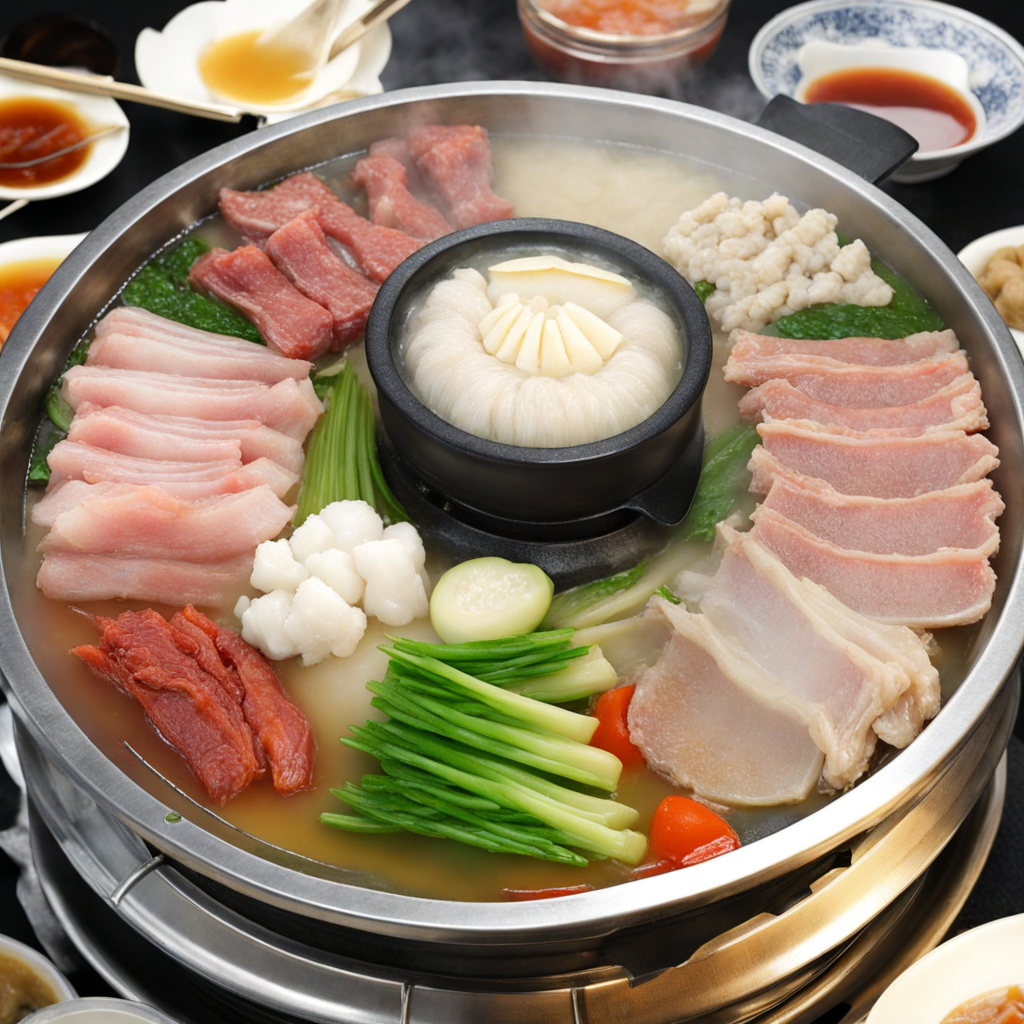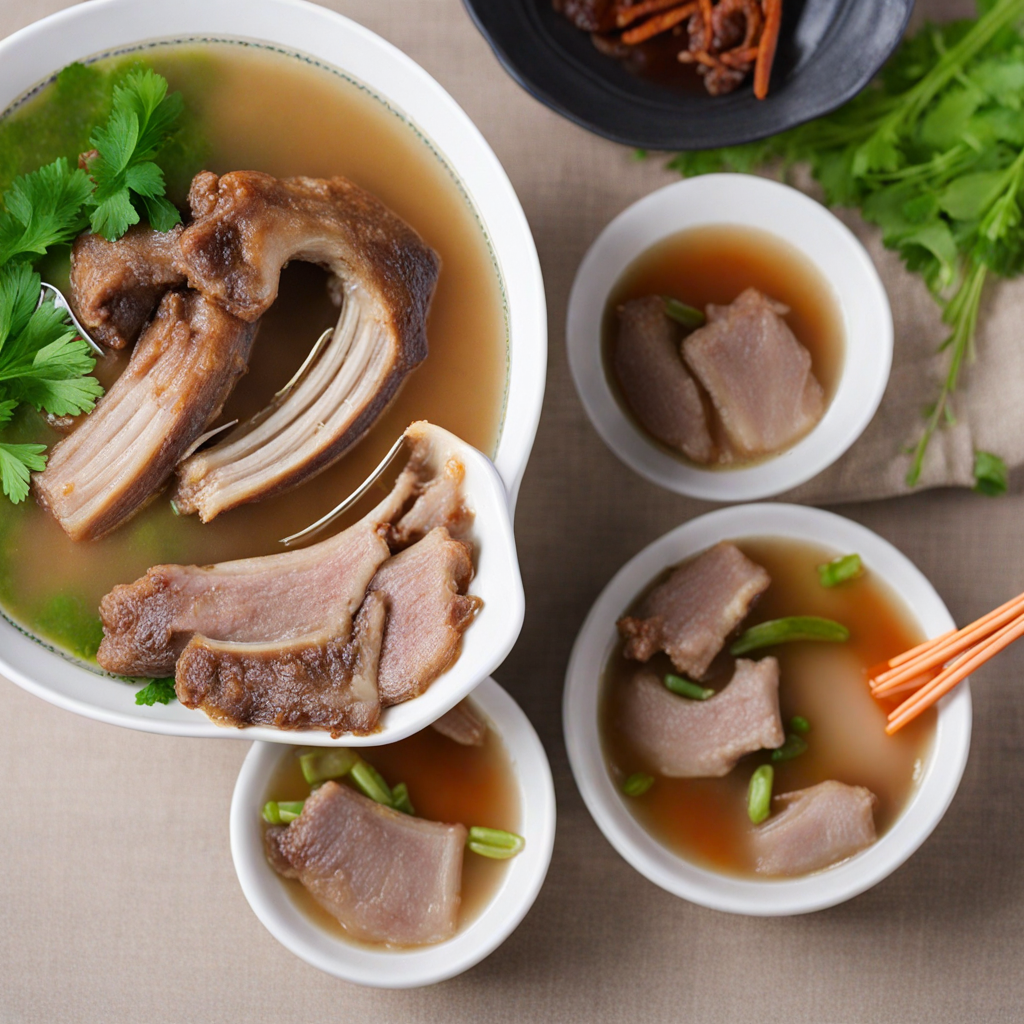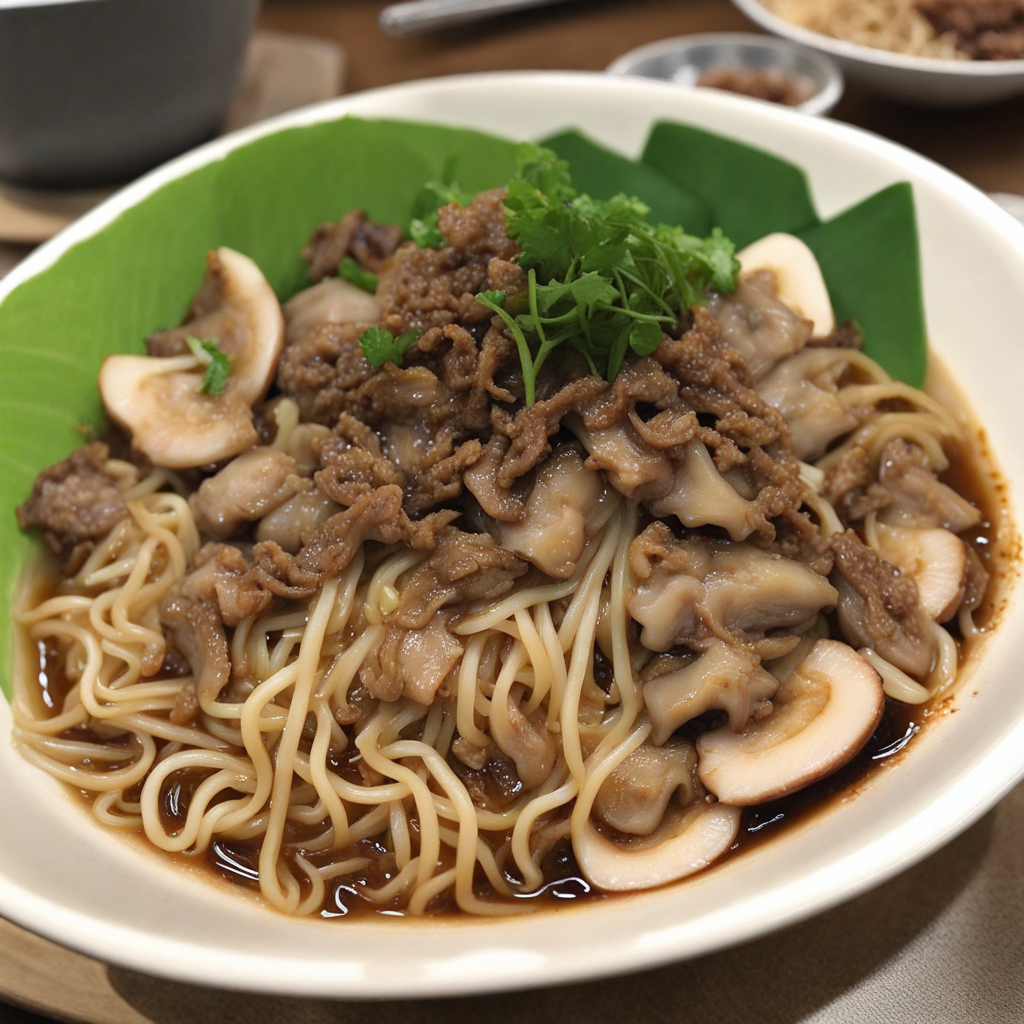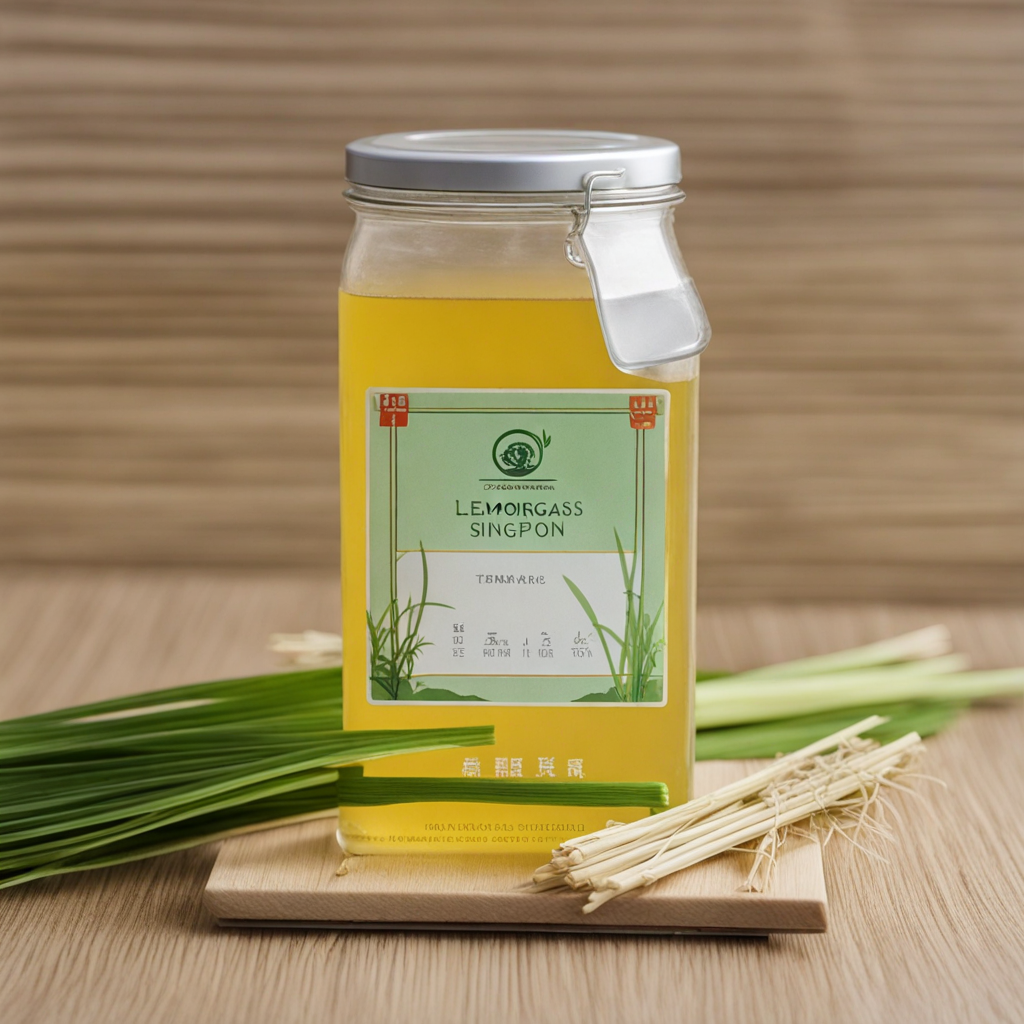Steamboat
Steamboat, a beloved culinary experience in Singapore, is a vibrant and interactive way of dining that centers around a bubbling pot of broth. Diners gather around a communal pot, where a variety of flavorful broths simmer, ranging from spicy Tom Yum to rich herbal chicken. This unique cooking method not only warms the soul but also allows for a delightful exploration of flavors as guests can customize their meal according to their preferences. The tantalizing aroma wafts through the air, enticing everyone to partake in this communal feast. As the meal unfolds, guests can choose from an array of fresh ingredients to cook in the broth. Thinly sliced meats such as beef, pork, and chicken are popular choices, alongside an assortment of seafood like prawns, fish, and squid. Vegetables, mushrooms, tofu, and noodles are also essential components, adding texture and depth to the meal. Each ingredient absorbs the rich flavors of the broth, creating a harmonious blend of tastes that is both satisfying and nourishing. The experience is enhanced by dipping sauces, ranging from zesty chili to savory sesame, allowing diners to elevate each bite with an extra burst of flavor. Steamboat is more than just a meal; it’s a social event that encourages sharing and bonding over food. Friends and family gather around the pot, chatting and laughing as they cook their chosen ingredients to perfection. The slow, leisurely pace of the meal fosters a sense of togetherness, making it a cherished dining tradition in Singapore. As the evening progresses, the broth becomes richer and more flavorful, reflecting the communal effort and love put into the meal. Discovering steamboat is truly an adventure for the senses, offering a delightful fusion of flavors, textures, and a warm sense of community.
How It Became This Dish
The Journey of Hotpot (火锅) in Singapore: A Culinary Mosaic #### Origins of Hotpot Hotpot, or 火锅 (huǒguō), is a beloved culinary tradition that has transcended its origins in China to become a popular dining experience across Asia and beyond. Its roots can be traced back to the nomadic tribes of Mongolia and the northern regions of China, particularly during the Han Dynasty (206 BCE – 220 CE). The concept of cooking food in a simmering pot of broth is believed to have originated from the lifestyle of these ancient nomads who relied on communal meals to foster community and camaraderie. The traditional hotpot involves a simmering pot filled with broth, alongside a variety of raw ingredients such as thinly sliced meats, seafood, vegetables, and noodles. Diners would dip these ingredients into the broth, cooking them to their liking before savoring them with a range of dipping sauces. This communal style of eating not only emphasizes sharing but also allows for a personalized dining experience, making it a social activity that encourages interaction among diners. #### Cultural Significance In Singapore, hotpot has evolved into a significant part of the multicultural tapestry of its food scene. The city-state, known for its melting pot of cultures, has embraced hotpot as a culinary staple that reflects its diverse heritage. While the dish is primarily associated with Chinese cuisine, Singapore's hotpot offerings have been influenced by the country's rich blend of Malay, Indian, and Peranakan cultures. The cultural significance of hotpot in Singapore extends beyond just food. It represents the spirit of togetherness and familial bonds. Many Singaporeans enjoy hotpot during family gatherings, celebrations, and even casual outings with friends. The act of cooking together at the table fosters a sense of unity and interaction, making each meal an event. Moreover, hotpot is often associated with festive occasions, such as Lunar New Year, where families gather to share blessings and good fortune over a steaming pot of broth. #### Development Over Time Hotpot in Singapore has undergone significant transformations since its introduction. The dish gained popularity in the late 20th century, coinciding with the influx of Chinese immigrants who brought their culinary traditions with them. Early hotpot establishments primarily featured traditional Cantonese-style broth and ingredients, appealing to the tastes of the Chinese diaspora. However, as Singapore's food landscape evolved, so did the hotpot experience. The 1990s and early 2000s saw a surge in hotpot restaurants, each vying to offer unique flavors and experiences. The emergence of new broths, such as spicy Sichuan, rich herbal, and savory tom yum, reflected the growing demand for diverse culinary experiences. This period also marked the introduction of innovative ingredients, including premium cuts of meat, seafood, and even exotic mushrooms, catering to the evolving palate of Singaporeans. The advent of technology and globalization further influenced the hotpot scene. Diners began to seek out more personalized experiences, leading to the rise of "DIY" hotpot restaurants where guests could select their own ingredients from a buffet-style setting. This allowed for greater experimentation with flavors and combinations, enabling patrons to tailor their meals to their preferences. #### The Globalization of Hotpot As Singapore positioned itself as a global culinary hub, hotpot quickly gained international recognition. The city's vibrant food scene attracted tourists and food lovers from around the globe, leading to the establishment of numerous hotpot chains and restaurants that showcased Singaporean adaptations of the dish. In recent years, the concept of hotpot has spread beyond Asian communities, with non-Asian diners embracing the communal and interactive dining experience. Singapore's hotpot culture has also seen the incorporation of international influences. For instance, Korean-style hotpot, known as "jeongol," and Japanese "shabu-shabu" have made their mark, offering new flavors and cooking techniques. This fusion of styles has led to the development of unique offerings, such as cheese-laden hotpot and dessert hotpot, which appeal to adventurous eaters seeking novel experiences. #### Contemporary Hotpot Scene Today, Singapore boasts a vibrant hotpot scene that caters to a diverse range of tastes and preferences. From traditional establishments serving classic Cantonese-style hotpot to modern dining experiences that incorporate global influences, there is something for everyone. The popularity of buffet-style hotpot restaurants, where diners can enjoy unlimited selections, has surged, particularly among young people and families looking for an engaging dining experience. Health-conscious diners have also influenced the hotpot landscape. Many restaurants now offer vegetarian and vegan options, as well as healthier broth choices, such as collagen and low-sodium variants. The emphasis on fresh, high-quality ingredients has become a hallmark of the contemporary hotpot experience, with many establishments sourcing local produce and sustainable seafood. Moreover, the rise of social media has played a significant role in shaping the hotpot culture. Diners are eager to share their hotpot experiences online, showcasing vibrant spreads of ingredients and unique dipping sauces. This has not only influenced consumer choices but has also encouraged restaurants to innovate and enhance their offerings to stand out in a crowded market. #### Conclusion The history of hotpot in Singapore is a testament to the dynamic nature of culinary traditions and their ability to adapt and flourish in new environments. From its humble origins rooted in communal dining to its contemporary status as a beloved social experience, hotpot embodies the spirit of togetherness and culinary exploration. As Singapore continues to evolve as a global food destination, hotpot will undoubtedly remain a cherished part of its culinary heritage, inviting everyone to gather around the pot, dip, cook, and enjoy the delicious flavors that define this iconic dish. Whether it’s a casual gathering with friends or a festive family reunion, hotpot will always hold a special place in the hearts—and stomachs—of Singaporeans and food lovers alike.
You may like
Discover local flavors from Singapore







